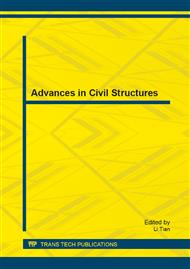p.1629
p.1637
p.1641
p.1648
p.1652
p.1657
p.1662
p.1669
p.1673
Research on Structural Present State and Damage Reasons of Ancient Tibetan Buildings
Abstract:
Due to different structural form, surrounding environment and external force, the damage of Ancient Tibetan buildings reflects its own characteristics. In this paper, the damage types of ancient Tibetan buildings are classified based on fieldwork, and then the damage reasons are studied. The main failure modes of ancient Tibetan buildings are damages and deformations of timber components and walls, including cracking and deflection of beams, column cracking, Queti slating, decay and cracking of rafters and cracking in walls. The damage reasons of ancient Tibetan buildings can be attributed to three aspects: degradations of timbers, structural defects and long-term external forces.
Info:
Periodical:
Pages:
1652-1656
Citation:
Online since:
August 2013
Keywords:
Price:
Сopyright:
© 2013 Trans Tech Publications Ltd. All Rights Reserved
Share:
Citation:


